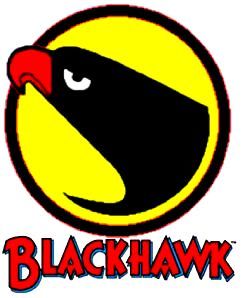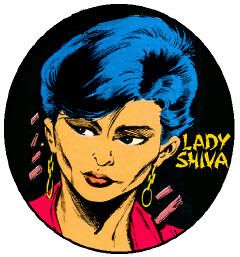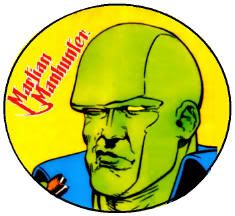
Marvel Comics had decided to celebrate its quarter-century anniversary, as marked by the publication of Fantastic Four #1 in the summer of 1961, a couple of different ways. One was a now-iconic gray border around select covers featuring style guide friendly versions of their top characters smiling at the readers as they encircled a different close-up head shot of the book's star-- probably at a reduced rate for that artist. You see, Cadence Industries had been the parent company of Marvel since 1968, but would soon be liquidated, with Marvel being prepped for sale. Corners were being cut wherever they could, with the greatest impact on the other element of the celebration-- the launch of a new imprint. Editor-in-Chief Jim Shooter may have saved Marvel Comics, and even the mainstream comics industry, by whipping it into professional and corporation-appeasing shape in the late 1970s, but he broke an awful lot of eggs making that omelet. He developed a reputation for being cruel, capricious, demanding, and egocentric. For instance, earlier today, I was reading about how classic inker Chic Stone was recovering from a heart attack when he was greeted by a letter of termination from Shooter. Favorite son John Byrne had just left the company specifically because of Shooter, after both had proven their loyalty by testifying against Jack Kirby in his lawsuit for the return of his artwork and intellectual property. The boss man had also awarded himself the massive royalties from writing the event maxi-series Secret Wars, and was driving everyone nuts nitpicking tie-ins to its broadly reviled sequel. There had been months of cryptic hype, with a series of house ads by Cynthia Martin showing a cosmic bolt traveling the solar system to strike the Earth, about what was known inside the industry as "The Shooterverse." In a n notable editorial, Shooter explained that this would be a line of adventure titles unconnected to Marvel continuity that would better reflect "the world outside your window." But again, within the industry, it was known as a boondoggle thrown together by moonlighting editors after hours for no money after the budget was slashed, on books staffed by unknowns and the exact types of aging veterans Shooter had been running out of Marvel for years prior. Whether through circumstance, incompetence, or intentional sabotage, this New Universe was seen as a monument to Jim Shooter's hubris whose failure would be ecstatically celebrated within the industry. But I was just a kid looking at the new comics at 7-11, knowing nothing of this beyond what Marvel's promotion had told me. According to Mike's Amazing World, there were two titles offered on the launch week. Spitfire and the Troubleshooters #1 was an immediate pass. I didn't know what a spitfire was, besides the clunky fire engine red robot on the cover. I didn't know what troubleshooters were either, but the dorks hanging off the robot had big TSR-80 Wiz Kids energy. The last straw though was the old-timey artwork by Herb Trimpe, not drawing in his more modern G.I. Joe Special Missions style, which wouldn't have worked with the Silver Age inks of Joe Sinnott anyway. Better odds were with Star Brand #1, for which star artist John Romita, Jr. had quit The Uncanny X-Men in an act of solidarity with Mein Kapitan. This was the only New Universe title that Jim Shooter himself wrote, about a guy who in most ways resembled Shooter himself, as a writer-insert. Blonde motorbike Shooter stand-in met an old man in the woods who gave him cosmic power tied to a sort of movable tattoo that was blatantly swiped from the Eclipse Comics moon & star colophon. Besides ridiculing the Marty Sue lead, critics also pointed out that the scale of the Star Brand's power, and his fighting a tentacle-alien that wielded laser rifles and wore power armor, was a pretty big leap past the grounded reality that was being forced upon every other book in the "Shooterverse." I wasn't yet adapt enough at recognizing art styles to notice that this was a penciller that I had been enjoying elsewhere, plus that first issue was very heavy on mundane character interaction. Worse, the Star Brand's power set and goofy alien foe recalled the Superman comics that I had rejected in my youth. Probably the worst was the cover, where inker Al Williamson had obliterated any trace of Romita's style to show the hero floating in space... just like a typical Superman image. So I put it back, and only dug the run out of the quarter bin of Marauder Books in 1989. The New Universe was failing to launch. Two more New Universe titles arrived for the fourth week of July. Nightmask #1 was another pass. While the cover image well communicated that our hero was a teen who, with the helped of his wheelchair-bound sister, could cast himself as a black-leotarded sleepy-time hero into dreams... it also looked like a Mad Magazine parody of something like Dreamscape. Once again, I didn't know what a night mask was, so the pun was lost on me, as was any appeal from the fay and unimaginative silhouette costume. Once again, writer Archie Goodwin had normal people in plain clothing talking way too much to overcome the generic fantasy ogre when it finally came time for battle. Tony Salmons was never a fanboy favorite, so having him inked by the also unloved Bret Blevins was like a Vegemite and sardine sandwich. It was as if when Shooter stole the Star Brand from Eclipse, he also tried to take their Marvel Lite company-owned titles like The New Wave and Freedom Project. I only got a few of these out of the quarter bin. Psi-Force #1 finally broke the New U's unlucky streak. I can usually spot Kyle Baker's inks from a mile away, and there are traces here and there, but he exercised an uncommon fidelity to Mark Texeira's line that I approved of. I'd encounter Tex here and there over the years, but this was the book that finally got my full attention. Steve Perry's story was very indebted to Stephen King ESP-infused thrillers like Firestarter, Carrie, and The Dead Zone, though some of that may have been under the orders of co-creators Archie Goodwin and Walter Simonson. A rogue C.I.A. agent uses his paranormal abilities to gather together five similarly gifted teenagers before they can be recruited or killed by various nefarious organizational entities. He's killed in the process, but his likeness is seen in a gestalt being periodically generated by the kid's combined abilities. This "Psi-Hawk" was heavily indebted to the Infinity Man of Kirby's Forever People, or more recently the phoenix from Gatchaman and the Lion Force Voltron. Psi-Force wasn't the only contender for the slot of X-Men in the New Universe, but as an X-Men fan, I thought it was off to a pretty good start in clenching the title. My half-brother's mother was adopted from Ireland, and he always made a big deal about those roots, so that may have contributed to his buying Web of Spider-Man #20, with Peter Parker reporting on the IRA. After a couple years' worth of irregular and parasitic reading, I finally returned to buying Captain America with #323. It was another one of those Marvel 25th anniversary head shots, and I was always a sucker for a grinning Cap. I still struggled with Paul Neary's art, one of the main reasons that I wasn't keeping up with the book, but I was intrigued by the premise of "Super-Patriot Is Here." Mark Gruenwald had been throwing a lot of ideologically-opposed opponents at Cap, but here was a guy that claimed to better represent modern America, and certainly a more crass and cynical one. I spent most of my childhood resting my head on a bicentennial pillow, and I considered myself patriotic, but maybe the jingoism of Reagan's America was starting to get to me? Or maybe I just thought Super Patriot looked cool, and I liked seeing Cap fight a guy who weaponized his own identity against him? Anyway, the storyline hooked me, and I'd keep up with it. The third week of New Universe releases continued the batting average of the second. Kickers, Inc. #1 introduced a football player who gained super-abilities that he used to form some sort of detective agency with some of his teammates? Man, this book made Super Powers hold its beer. I responded way better to Mark Hazzard: Merc #1, which seems to have put me at odds with the buying public, as usual. I wasn't following writers at the time, but this was written by the same guy that had done "The Death of Jean DeWolff," and I think I appreciated that same darkly humorous streak. Rejoining Peter David, if only for the cover, was Mark Beachum, who brought a Punisher vibe at a time when I was probably suffering slight withdrawals. The interiors were by Gray Morrow, another aging industry veteran with a dated style that I'd had little, unwelcome exposure to. However, that gritty graphite look worked for a "realistic" war story, reminding me a bit of Gene Colan, and Morrow had made his biggest splash on '70s Warren magazines, so he knew the territory. But mostly, I just took an immediate liking to Marc Hazzard. He was a tall, stocky guy with thinning hair that reminded me a little of my father. Hell, they both even had a big wooden African tribesman shield on their walls, if you can believe it. They both also had a way with the ladies and an estranged son from a past relationship, but I doubt my father was helping to overthrow South Pacific dictatorships on his weekends like Marc. To me, this was kind of a perfect first issue, with a done-in-one story that sets up the entire supporting cast, a fair amount a sexual titillation and brital violence, sprinkled with humor, lots of teases of the lead character's backstory and foreshadowing his unique circumstance as a soldier-for-hire trying to reconnect with his child. It was immediately my favorite New Universe title, and easily came the closest to fulfilling the line's mandate. So of course it was treated as the bastard stepchild, and not only the first title on the chopping block, but also the series that ended only after killing off its titular star. Though in that regard, it did set a precedent. So I guess this also re-calibrates my batting average, because I'll end up following both the longest and the shortest lived New U titles, but only for part of their first year. Only year, in Marc's case. Though it probably helps to have Silver Surfer, punk Storm, and black suit Spider-Man on the front of Sif to Sunspot, the front cover to The Official Handbook of the Marvel Universe Deluxe Edition #12 hardly misses a beat from losing Byrne in favor of Ron Frenz, already a brawny classical Marvel artist. A tough Buscema-style Namor on the back cover couldn't hurt, though. This issue struggles through a lot of group entries, but we also get Michael Golden, Art Adams, and Paul Smith. Son of Ambush Bug #5 also got double-shipped this month, plus Keith Giffen had taken over the final issues of Hex, which might explain the four pages randomly drawn by Steven Bissette after the Bug bit Keith's pencil in half. Actually, "random" describes everything this issue, including how I came to it. I think I missed this one on the newsstand, and bought it newish off the rack of that baby comic shop inside the South Houston antique mall/flea market that we only occasionally visited. After repeating the opening gag of a magazine parody from last issue, this time Comic Buyer's Guide, we follow Irwin Schwab's imprisonment and kangaroo court trial for contempt of comics, with Two-Face serving as both defense attorney and prosecutor. We didn't say "meta" in the mid '80s, but the subtext has devoured the text, with the Bug serving as a stand-in for Giffen as he indicts himself for his inability to do what the fans want, and DC's unwillingness to let him do what he wants. The issue is a thinly veiled angry screed about how a character premised on being a Looney Tunes-style annoyance to Superman, who moves on to mocking the greater DC Universe, has been denied access to anything related to DC Comics. Notoriously, no one wanted to allow their heroes to appear in the upcoming funny Justice League relaunch, but Denny O'Neil took pity on the book and allowed the use of Batman in the earlier part of the run. After taking repeated jabs at the Superman office, it's telling that a Batman villain is the biggest "get" for this mini-series. We've forgotten about the Uh-Oh Squad, the government plot to use the suit's teleportation technology is abandoned in favor of a circular logic gag, Cheeks does a very on-the-nose DKR image followed by an uninspired Elmer Fudd lift, we're doing the Ditko objectivism as Kafka riff again, there's the tangent in the prehistoric Gorilla City-- it's just a bunch non-sequiters to fill out the page count. I know that the book was trying my patience now, there weren't really jokes to get, and the whole project seemed to sour. I think I saw the sixth issue on the stands, but lollygagged until it wasn't, and didn't complete the mini-series until I got it as a back issue from a shop in 1987. And even then, I think I'd tried the earlier, funnier mini-series, and loving that, finally resolved this one. I knew a lot of this went over my head at the time, but reading it as a comics-learned adult who's older than the creators were at the time, the series just makes me sad. Giffen was so bitter and lost, Robert Loren Fleming is barely hanging on in his anarchic scripting, and I shudder to think how things would have turned out for these talents if not for the breakout success of JLI. But I can say that I still really love the art on this thing, especially when Giffen would just draw some ugly weirdo in a panel for kicks.

















No comments:
Post a Comment